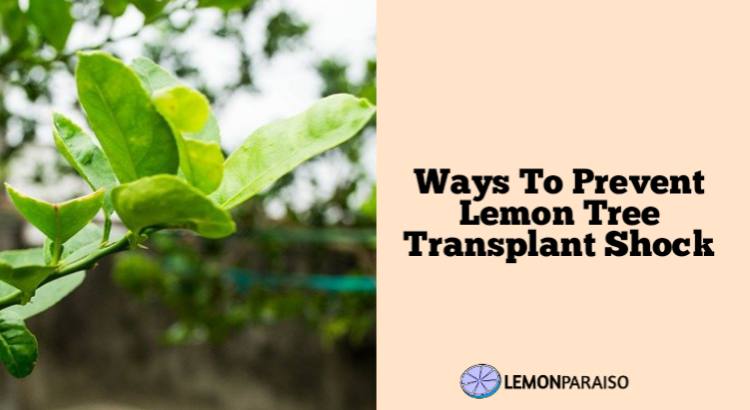Ways To Prevent Lemon Tree Transplant Shock

When you buy new lemon trees from the nursery and you bring them home, sometimes you plan to transplant them into the ground.
There are many benefits of growing a lemon tree in the pot or in the soil, both are great for the tree. But there are times when you transplant your lemon tree a transplant shock happens. How will you prevent transplant shock on the lemon trees?
Signs Of Transplant Shock On Lemon Tree
Some of the signs of lemon tree transplant shock are dropping leaves, curling leaves, yellowing leaves, brown tip leaves, scorched leaves, stunted twigs, and poor flower and tree growth.
Transplant shock is common for all kinds of plants and trees and it happens because the plant or trees are transplanted to a new environment and it causes stress. Just an example, if your lemon tree is growing well in a tropical climate location and you transfer them, transplant shock may happen.
Some of the lemon trees are small. They grow only a few feet and they can be grown in a container/pot. There are people who have potted lemon trees and want to transplant them into the ground and the problem happens. But how to make transplanting be successful and prevent transplant shock?
Ways To Prevent Transplant Shock On Lemon Tree
Do Not Shake Or Bump The Soil
When you are going to transplant your lemon tree, you need to prevent shaking or bumping the soil. The roots should still hold the soil and try to prevent it from falling.
The lemon tree is comfortable with the soil where they are standing or holding on so avoiding shaking so you can prevent tree stress. Being careful with handling the lemon tree will be the key to making the transplanting successful.
Don’t Expose The Lemon Roots Into The Air For Too Long
Air exposure can cause transplant shock. When you are transferring your lemon tree to a new environment, you should do it a bit faster to prevent too much air exposure. The roots of the tree love to stay in the soil.
They don’t want to be exposed to the air because it is not where they live. You need to plan and prepare well when you are going to transfer your lemon tree so that it will not be exposed to air for too long.
Bring More Roots
If your lemon tree is planted in the ground and you want to move them to another place, digging them out will be a little bit difficult. It takes some time to dig the soil and move your lemon tree out and try to make sure that there will be more roots.
And also the taproot should not be cut, especially when the plant is too young and small. If the lemon tree is big and has more roots, cutting a small portion of the taproot will be fine because the other roots will work to transport nutrients and water into the tree.
Water thoroughly
After transplanting you should water the lemon tree thoroughly and make the soil moist not too soggy. The lemon tree will settle in the new environment once they get enough water.
Also, root rot is common for citruses so you need to prevent overwatering. When root rot happens, the lemon tree will not get water and nutrients because the functions of its roots are affected.
Purchase Them Small
Small lemon trees have a lower chance of getting transplant shock. So when you buy and transplant them small, there will be a higher chance of getting transplanting successful.
Big lemon trees are more prone to transplant shock than smaller trees. But the only problem with small and young lemon trees is that they take more time to produce fruit.
How To Fix Lemon Tree Transplant Shock?
There are some causes that may cause transplant shock on lemon trees and there are some things that you can do to fix the problem. When transplant shock happens, you need to make sure that you give the lemon trees enough water.
Check the soil by pressing your index finger 2 to 3 inches deep, if the soil is dry you need to water lemon trees but if still moist you don’t need to. Another way to check your soil moisture is to use a screwdriver.
You need to push the screwdriver in the soil and if it pushes you don’t need to water, but if it doesn’t and the soil is too hard you need to. The other thing you can do is wait for the trees to recover. It can take a few weeks to see a good sign. You need to take care of lemon trees to keep them growing.
How Long Does It Take For A Lemon Tree To Recover From Transplant Shock?
When transplant shock happens, lemon trees can recover within 2 to 3 weeks especially if they are small but it will take around a year for some big lemon trees.
During those times you need to make sure they are getting their needs like water and sunlight. Once the tree is getting better, the lemon tree’s lifespan will go great.
Adding fertilizer should be done after a month or two when the lemon tree is getting established. Fertilizers especially chemicals can cause burning on the roots so it is better not to give one especially when the tree is experiencing transplant shock.
When the lemon tree is transplanted successfully it will grow better, will thrive, and will produce fruits in the upcoming years. You will get your first lemons when the tree is 3 to 5 years old.

